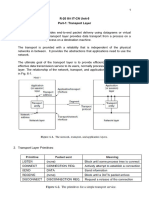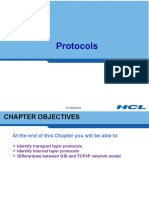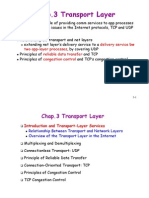Chapter 3 Midterm Review
Chapter 3 Midterm Review
Uploaded by
virsago42Copyright:
Available Formats
Chapter 3 Midterm Review
Chapter 3 Midterm Review
Uploaded by
virsago42Copyright
Available Formats
Share this document
Did you find this document useful?
Is this content inappropriate?
Copyright:
Available Formats
Chapter 3 Midterm Review
Chapter 3 Midterm Review
Uploaded by
virsago42Copyright:
Available Formats
Chapter 3:
3.1 Introduction and Transport-Layer Services
logical communication - the connection between two hosts is as if both hosts were directly connected, when in reality they could be communicating through many routers and other link types as far away as possible. Transport -layer protocols ensure that both hosts do not need to be connected directly in order to communicate with each other. Applies only between processes. segment - a message from the sending host that is converted and broken into smaller pieces by the transport-layer. The transport-layer adds transport-layer headers to each piece of data, then sends the segment to the network-layer protocol so it may be added to a network-layer packet (datagram) and sent to the destination. The transport-layer data is not acted on by network routers. Instead, the transportlayer on the receiving side extracts the transport-layer segment data and processes the data so it may be used by the receiving application. Network applications may use more than one transport-layer protocol, such as TCP or UDP.
3.1.1 Relationship Between Transport and Network Layers
The network layer provides logical communication between hosts. Analogy: Two houses, A and B, send mail to each other. The post office delivers mail to house A and house B. Person A receives the mail and disperses it to its recipients within the house, and Person B does the same thing for their home. The post office provides logical communication to Person A and Person B, and Person A and Person B provide logical communication to the mail recipients in their home. application messages = letters in envelopes processes = people within each home (not Person A or Person B) hosts = houses transport-layer protocol = Person A and Person B network-layer protocol = postal service Different transport-layer protocols may function differently than the way seen in this model. For example, some protocols are less reliable than others and may result in lost or corrupted data. Transport-layer protocols are often affected by the limitations of the underlying network-layer protocol. For example, if the network-layer protocol cannot provide
delay or bandwidth guarantees for transport layer segments between hosts, then the transport-layer protocol cannot provide delay or bandwidth guarantees for application messages between processes. However, the transport-layer protocol is capable of providing services that the network-layer protocol may not provide, such as reliable data transfer if the networklayer protocol is unreliable (loses, damages, or duplicates packets), and encryption to prevent intruders from reading application messages, even if the network-layer protocol cannot guarantee segment confidentiality.
3.1.2 Overview of the Transport Layer in the Internet
A transport-layer packet for TCP is referred to as a segment. A transport-layer packet for UDP is referred to as a datagram. IP - Stands for Internet Protocol. Provides logical communication between hosts. Provides best-effort delivery service - makes its "best effort" to deliver segments between communicating hosts, but makes no guarantees. In particular, IP does not guarantee orderly delivery of segments and does not guarantee the integrity of the data. For this reason, IP is called an unreliable service. Note: Each host has an IP address. The most fundamental responsibility of UDP and TCP is to extend IP's delivery service between two hosts to a delivery service between two processes on the end systems. This is called transport-layer multiplexing and demultiplexing. UDP and TCP provide integrity checking by including error-detection fields in their segments' headers. UDP only provides multiplexing/demultiplexing and error checking, so it is said to be an unreliable service because it does not guarantee data will be sent intact to the destination. TCP provides the same service as UDP along with several additional services such as reliable data transfer (the use of flow control, sequence numbers, acknowledgements, and timers) to ensure data is deliver from the sending process to the receiving process correctly in order. TCP converts IP's unreliable service between end systems into a reliable data transport service between processes. TCP also provides congestion control, which prevents excessive traffic between hosts by regulating the amount of connections that can be made and sharing bandwidth equally between all connections. This is not provided by UDP.
3.2 Multiplexing and Demultiplexing
Transport-layer data is delivered to an intermediary socket. Sockets are identified uniquely depending on whether the socket is a UDP or TCP socket.
Demultiplexing: the delivery of transport-layer segments to their correct socket. Each segment is assigned a source port number and destination port number. When the segment arrives at the host, the transport layer examines the destination port number in the segment and sends it to the corresponding socket. Multiplexing: the gathering of data pieces at the source host from different sockets, encapsulation of each data piece with header information to create segments, and passing of the segments to the network layer. Source port number field: segment field that identifies which port the segment came from. The source port number is extracted from the segment by the destination host, then a response is sent using the source port number as the destination port number. Destination port number field: segment field that identifies which port the segment should be delivered to. Well-known port numbers: port numbers from 0-1023. Restricted and reserved for well-known application protocols like HTTP (80) and FTP (21). UDP sockets are identified by two numbers: destination IP address and destination port number. TCP sockets are identified by four numbers: source IP address, source port number, destination IP address, and destination port number. Segments sent to Web servers always have a destination port number of 80.
3.3 Connectionless Transport: UDP
UDP is preferable to TCP in situations where congestion control is not preferred, such as with real-time applications that require a minimum sending rate. The application may apply additional functionality beyond UDP's barebones delivery service. It is also preferable when no connection establishment is needed, such as for DNS, or when a maintained state of connection is not necessary. Finally, UDP segments only have 8 bytes of header overhead, whereas TCP packets have 20 bytes. A checksum is used by the receiving host to check for errors. It is used to determine
whether bits within the UDP segment have been altered during delivery by performing the 1s complement of all sum of all the 16-bit words in the segment, with any overflow encountered during the sum being wrapped around. UDP segments with errors are handled differently depending on the application - some discard the segments, while others warn that the segment is damaged, and some don't do anything.
You might also like
- ENSDWI Training New ENSDWI QuestionsDocument17 pagesENSDWI Training New ENSDWI QuestionsCesar Campos LimaNo ratings yet
- Technical Information: SMA Modbus Interface For Sunny Boy / Sunny TripowerDocument77 pagesTechnical Information: SMA Modbus Interface For Sunny Boy / Sunny Tripowermed abdelmalek100% (1)
- 3.1 Introduction of Transport Layer ServiceDocument4 pages3.1 Introduction of Transport Layer ServicesharzaNo ratings yet
- Chapter3 SummaryDocument42 pagesChapter3 Summaryandrewakram57No ratings yet
- CN Unit-5 MaterialDocument27 pagesCN Unit-5 MaterialsuneelkluNo ratings yet
- 962batransport Layer and UDPDocument7 pages962batransport Layer and UDPPranjalNo ratings yet
- EC3401 NS UNIT 3 NOTES EduEnggDocument23 pagesEC3401 NS UNIT 3 NOTES EduEnggPriyadharshini KNo ratings yet
- Transport LayerDocument22 pagesTransport Layeryadajyothsna04No ratings yet
- Practical No. 12 TCP-IP ModelDocument4 pagesPractical No. 12 TCP-IP Modelnikhilwankhede0707No ratings yet
- Computer Networks Udp and TCP: Figure 1: DLC, Network, TransportDocument11 pagesComputer Networks Udp and TCP: Figure 1: DLC, Network, TransportlinchiNo ratings yet
- Client/Server Paradigm: Mod 4 Process-To-Process DeliveryDocument29 pagesClient/Server Paradigm: Mod 4 Process-To-Process DeliverySUREDDY TANUJA MSCS2018No ratings yet
- CN Unit4 NDocument30 pagesCN Unit4 NsaeuhsaoteuNo ratings yet
- Module 2 - Transport LayerDocument11 pagesModule 2 - Transport LayerAnkit RajNo ratings yet
- Lecture 6 Sumcsc 430Document4 pagesLecture 6 Sumcsc 430omarobeidd03No ratings yet
- Network Layer Samia'Document10 pagesNetwork Layer Samia'Dark GardianNo ratings yet
- Chap13-The Transport Layer ProtocolsDocument25 pagesChap13-The Transport Layer ProtocolschieclagreenNo ratings yet
- Chapter 5Document16 pagesChapter 5Honor SwiftNo ratings yet
- Cs3591 - CN Unit 2 Transport LayerDocument15 pagesCs3591 - CN Unit 2 Transport LayerB ALFINO ChristNo ratings yet
- Fundamentals To NetworkDocument14 pagesFundamentals To NetworkDinesh MathewNo ratings yet
- UNIT 4 ACN UpdatedDocument68 pagesUNIT 4 ACN UpdatedagasyabutoliaNo ratings yet
- Unit 4Document25 pagesUnit 4dharineesh.1102No ratings yet
- DCN-Unit IIDocument30 pagesDCN-Unit IIAmanNo ratings yet
- Transport Layer: Process-to-Process Delivery: Udp and TCPDocument74 pagesTransport Layer: Process-to-Process Delivery: Udp and TCP22Angira GhoshNo ratings yet
- CN Unit-4Document30 pagesCN Unit-4SaiNo ratings yet
- Chapter 5Document26 pagesChapter 5Parsal SilwalNo ratings yet
- Unit 4Document18 pagesUnit 4Manasa PNo ratings yet
- Lecture 5Document11 pagesLecture 5Rylan2911No ratings yet
- Notes U-5Document29 pagesNotes U-5Esha Thaniya MallaNo ratings yet
- Cnunit 4Document21 pagesCnunit 4mouryasaikarnati23No ratings yet
- Computer Networks: by K.Eugine Raj AP/SCAD Engg CollegeDocument20 pagesComputer Networks: by K.Eugine Raj AP/SCAD Engg CollegegkreuginerajNo ratings yet
- Design of A Wired Network Using Different TopologiesDocument12 pagesDesign of A Wired Network Using Different TopologiesSiva ShankarNo ratings yet
- Web and Internet Technology - UNIT-1-3Document4 pagesWeb and Internet Technology - UNIT-1-3bfloveff69No ratings yet
- Transmission Control Protocol: TCP/IP Services and Client/Server OperationDocument8 pagesTransmission Control Protocol: TCP/IP Services and Client/Server Operationkavas26No ratings yet
- CN Unit 5 Computer Network NotesDocument33 pagesCN Unit 5 Computer Network Notesgdsc.pragatiNo ratings yet
- Transport-Layer-And-ProtocolsDocument9 pagesTransport-Layer-And-ProtocolsMuhammad Taha RasoulNo ratings yet
- FT Lecture Notes 5 Transport Layer I Fall22Document9 pagesFT Lecture Notes 5 Transport Layer I Fall22woyecex875No ratings yet
- CN UNIT-5(com)Document25 pagesCN UNIT-5(com)pandhinaveen12No ratings yet
- Chapter03 SGDocument24 pagesChapter03 SGNadya OrtizNo ratings yet
- Unit 4 Transport LayerDocument9 pagesUnit 4 Transport LayerB4 BooksNo ratings yet
- Chapter 4 Transport LayerDocument31 pagesChapter 4 Transport LayerTanu SrivastavaNo ratings yet
- ProtocolsDocument22 pagesProtocolssharkapproachNo ratings yet
- Unit IV (CN)Document12 pagesUnit IV (CN)Abdul RehamanNo ratings yet
- TCP and Udp: by Steve Steinke, Network Magazine Feb 5, 2001 (10:03 AM)Document4 pagesTCP and Udp: by Steve Steinke, Network Magazine Feb 5, 2001 (10:03 AM)Karthick SubbiahNo ratings yet
- Transport Layer CNDocument24 pagesTransport Layer CNYuvaraj GoudarNo ratings yet
- CN Unit - 4Document40 pagesCN Unit - 421WH1A6642 KUKKAPALLY PRAHARSHITHANo ratings yet
- Computer Network Module - 3Document15 pagesComputer Network Module - 3ankitupadhyay2241No ratings yet
- DCN 5th UnitDocument12 pagesDCN 5th UnitNallani SireshaNo ratings yet
- Edited Unit 4 CN 4TH SemDocument8 pagesEdited Unit 4 CN 4TH Sempawanchourasia0329No ratings yet
- The User Datagram ProtocolDocument10 pagesThe User Datagram ProtocolSHAGUFTANAUREENNo ratings yet
- Study of TCP Throughput On Network Simulator Opnet++ by Using Different ParametersDocument6 pagesStudy of TCP Throughput On Network Simulator Opnet++ by Using Different Parametersgovind_misraaNo ratings yet
- CN-Unit-1 - Part2 NotesDocument9 pagesCN-Unit-1 - Part2 NotesMeghnadhNo ratings yet
- CN UNIT 4 Transport LayerDocument32 pagesCN UNIT 4 Transport Layerharsharewards1No ratings yet
- TCP ProtocalDocument30 pagesTCP ProtocalNaresh PatnanaNo ratings yet
- Lecture 11Document17 pagesLecture 11تُحف العقولNo ratings yet
- Role of The Transport Layer: Tracking Individual ConversationsDocument5 pagesRole of The Transport Layer: Tracking Individual ConversationsAnonymous vWJXWUNo ratings yet
- Computer Networking Chap3Document102 pagesComputer Networking Chap3feelif100% (6)
- Transport Layer and Application LayerDocument10 pagesTransport Layer and Application LayerWahid ShaikhNo ratings yet
- TCP IpDocument11 pagesTCP IptherealmukanyaNo ratings yet
- The Reference Model Part 2Document6 pagesThe Reference Model Part 2roysayanccp05No ratings yet
- Transport Layer: Pawan Kumar Assistantprofessor Gjus&T, HisarDocument26 pagesTransport Layer: Pawan Kumar Assistantprofessor Gjus&T, HisarG100 -vishantNo ratings yet
- Hacking Network Protocols: Unlocking the Secrets of Network Protocol AnalysisFrom EverandHacking Network Protocols: Unlocking the Secrets of Network Protocol AnalysisNo ratings yet
- Introduction to Internet & Web Technology: Internet & Web TechnologyFrom EverandIntroduction to Internet & Web Technology: Internet & Web TechnologyNo ratings yet
- Srxp4-2v10-Emd - DatasheetDocument8 pagesSrxp4-2v10-Emd - DatasheetreportemoreliatecNo ratings yet
- Liebert-IntelliSlot-Unity-Card - SNMP & MODBUS USER MANUELDocument64 pagesLiebert-IntelliSlot-Unity-Card - SNMP & MODBUS USER MANUELdenizkaplanogluNo ratings yet
- 3 Ijcse 01994Document5 pages3 Ijcse 01994Adela VukasNo ratings yet
- Internet Protocols Seminar ReportDocument14 pagesInternet Protocols Seminar ReportAkash NandeNo ratings yet
- Bacnet Router DatasheetDocument13 pagesBacnet Router Datasheetdnps2011No ratings yet
- Usefull Info NetworkingDocument33 pagesUsefull Info Networkinggongasir81No ratings yet
- Module-4-TransportLayer - 6.1 - 6.2Document57 pagesModule-4-TransportLayer - 6.1 - 6.2sachins.2021.becsNo ratings yet
- Ruma - 1 - Mod1 06012015Document104 pagesRuma - 1 - Mod1 06012015Vivek SinghNo ratings yet
- (FREE PDF Sample) F5 Networks Application Delivery Fundamentals Study Guide Black and White Edition Philip Jönsson Steven Iveson EbooksDocument49 pages(FREE PDF Sample) F5 Networks Application Delivery Fundamentals Study Guide Black and White Edition Philip Jönsson Steven Iveson Ebooksdorantduffy100% (3)
- 2SIT325-21P Network Performance Evaluation-TaskSheetDocument5 pages2SIT325-21P Network Performance Evaluation-TaskSheetNarendraNo ratings yet
- 90210-1190DEA TCP IP Communication Man PDFDocument55 pages90210-1190DEA TCP IP Communication Man PDFVICTORSJ100% (1)
- CS2307 LabManualDocument90 pagesCS2307 LabManualDinesh BoobalanNo ratings yet
- CSE252Document87 pagesCSE252abhaNo ratings yet
- Configuring Cisco Ios Ip Slas OperationsDocument8 pagesConfiguring Cisco Ios Ip Slas OperationsNishant MishraNo ratings yet
- Nxlog Reference ManualDocument165 pagesNxlog Reference ManualmikecosoNo ratings yet
- FortiOS-6.0-Hardening Your FortiGateDocument29 pagesFortiOS-6.0-Hardening Your FortiGateAkram AlqadasiNo ratings yet
- CCE Detailed SyllabusDocument106 pagesCCE Detailed SyllabusMadhavan ShahNo ratings yet
- Intellect - Manual DVT CameraDocument128 pagesIntellect - Manual DVT CameraOscar ReyesNo ratings yet
- Linux Desktops Setup PDFDocument144 pagesLinux Desktops Setup PDFMalik RiahiNo ratings yet
- CNL Oral Sample QnsDocument2 pagesCNL Oral Sample Qnshrishi77No ratings yet
- LTE - RF Optimization (Alcatel-Lucent Internal)Document43 pagesLTE - RF Optimization (Alcatel-Lucent Internal)ravylla55100% (1)
- SERVICE GUIDE Svc-Imageclass-X-Mf1127c-Service-Guide-DealersDocument42 pagesSERVICE GUIDE Svc-Imageclass-X-Mf1127c-Service-Guide-DealersTroyNo ratings yet
- Broadcom Support Guide v3.03Document70 pagesBroadcom Support Guide v3.03gwakinNo ratings yet
- TCP IP ModelDocument13 pagesTCP IP ModelRanjeet SinghNo ratings yet
- ONVIF Core SpecificationDocument122 pagesONVIF Core SpecificationLong HaNo ratings yet
- ArmorNMS Instructions PDFDocument4 pagesArmorNMS Instructions PDFaristidezzNo ratings yet
- Transport Layer: Computer Networking: A Top Down ApproachDocument19 pagesTransport Layer: Computer Networking: A Top Down ApproachMd Rakibul IslamNo ratings yet
- Ipt3 Expert Level Support GuideDocument266 pagesIpt3 Expert Level Support GuideLyndon DoddsNo ratings yet

























































































